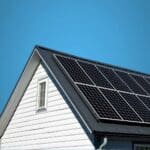This article is from the March 17, 2021, issue of Flip the Script, a weekly newsletter moving you from climate stress to clean energy action. Sign up here to get it in your inbox (and share the link with a friend).
Gen180’s Matt Turner wrote this post back in late 2018; as spring 2021 arrives (thank goodness), it’s as relevant as ever. A 2021 update at the end checks back in on Matt’s life today, 2.5 years after writing the initial post.
The broken cord just hung there, yellowed with age and not sure of what to do or what to be. This particular cord had held for seven years and had served its purpose well—until this balmy July afternoon.
It used to be the pull cord for a weed trimmer. For years, it would faithfully listen to my grunts and curses as I abused it, struggling to start it up again after a long winter. It would wait patiently as I mixed my two-cycle gas like a chemist in a lab, primed the carburetor with the rubber squeeze bulb, and opened the choke. Then I would aggressively yank that cord like it had slighted me.
Inevitably, after minutes of enduring my frustration, the pull cord would do its job and turn the crankshaft to start the engine. I always had a sense of accomplishment when it started—like I had tamed some fearsome beast.

Tamed by the beast
But on this particular midsummer’s day, the pull cord failed me. After one pull, it snapped. I was left abandoned with a weed trimmer full of gas and ready to work, but with no key to ignite the fires within. I consider myself somewhat handy with tools and basic car repairs, so I was certain that with a little time and research, I could replace a simple pull cord.
As I opened the plastic paneling to reveal the cord housing, I realized that I’d slacked on quite a bit of maintenance over the years. Yes, the pull cord needed replacing, but so did the air filter, the fuel filter, and the spark plug, all of which were original to the machine and, according to the manufacturer, should have been replaced long ago.
After ordering the parts I needed, they arrived at my door within a week. I got to work the next available weekend. Garage open, tools out, music on, I began with the confidence of a seasoned surgeon ready to save a life.
After five hours of blood, sweat, and frustration, I stood back and looked at my handiwork. The concrete floor was permanently stained with fuel, my hands were covered in seven-year-old gunk and blood, and tools were splayed across the floor. I pulled the cord, and nothing happened. Two more times—nothing. Twenty minutes later, still no luck.
Five hours spent repairing a machine that is suppose to make my life easier. Five hours that I could’ve spent watching the game, or fixing that sink leak I’d been meaning to get to, or playing with my daughters. Five hours wasted.
Standing in my garage, I spotted the oil drip under the car that had been slowly leaking for months, and the SUV that had been having transmission issues, and the lawn mower that likely needed the same maintenance as the weed trimmer.
These problems are decades old. It’s 2018. There’s got to be a better way of doing things by now.

Better living with electricity
A good friend of mine who worked in landscaping recommended that I look into getting a new weed trimmer, but this time one that swaps out the internal combustion engine, the carburetor, the pull cord, the spark plug, and the fuel—all for a single battery. It sounded appealing.
After a little research, I found that the battery-powered trimmer cost about as much as the gas-powered one, and the reviews for the battery version were actually better. So I decided to make the jump to my first electric engine.
This isn’t a story to tell you how much I love my new weed trimmer (though I do) because it’s quieter (it is), saves me money (it does), weighs less (yup), and has better performance (that too). It’s the story of how I realized there’s a better way of doing things than we’ve done before.
These problems are decades old. There’s got to be a better way of doing things by now.
I don’t own an electric car yet, but I know that my next car will be one. The cost savings, convenience, performance, and overall experience of electric engines just blows the alternative out of the water. I didn’t start that summer day thinking I’d buy into the “electrify everything” movement. But I came out of it knowing that I’d never look back.
There’s probably some esoteric insight into how my journey from gas-powered small engine frustrations to electric engine happiness is a metaphor for the world’s current state of wrestling with the abundance of gas-powered vehicles and the need for cleaner power. But really, the insight is much simpler: there’s just a better way of doing things now, and it’s electric.
2021 update:
It’s been two and half years since I opened the door to the electrification of everything. That door turned out to be the lid to a pandora’s box of better (and cleaner) ways of doing things. In the spring of 2019 I purchased an electric mower. That same summer I purchased a used electric car and in the fall, we took it one step further and installed solar on our home. With every transition we’ve made there has been a marked improvement in our lives. I can confirm through first-hand experience, there’s definitely no going back.
It feels good that I’m now able to align my actions with what I believe in (cleaner air is better air)—but electrification really is just a better experience. My kids love how quiet and clean our electric car is. Even before getting solar, our EV cut our “fuel” costs in half. When coupled with solar panels, we were able to exchange our $300+ electricity/gasoline combined monthly costs for a $100 per month solar loan—a no brainer decision. I can now see the word-of-mouth effect of my solar panels and EV starting a ripple of positive impact in my family and my neighborhood.
There is still so much work to be done to make these solutions more accessible to more people. While the market is moving things in the right direction (e.g., more used and affordable EVs available for sale, improving technology making solar panels, HVAC, and yard tools cheaper to produce) the science is pretty clear that we need to step on the accelerator in a big way. Find ways that you’re able to get involved (one place to start) and get busy.
-Matt Turner, Creative Manager at Generation180















